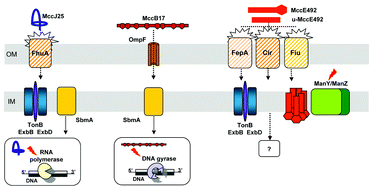Microcins, gene-encoded antibacterial peptides from enterobacteria
Abstract
Covering 1982 to 2006
Microcins are gene-encoded antibacterial

* Corresponding authors
a Laboratory of Chemistry and Biochemistry of Natural Substances, UMR 5154 CNRS, Department of Regulations, Development and Molecular Diversity, National Museum of Natural History, CP 54, 57 rue Cuvier, Paris, France
Covering 1982 to 2006
Microcins are gene-encoded antibacterial

 Please wait while we load your content...
Something went wrong. Try again?
Please wait while we load your content...
Something went wrong. Try again?
S. Duquesne, D. Destoumieux-Garzón, J. Peduzzi and S. Rebuffat, Nat. Prod. Rep., 2007, 24, 708 DOI: 10.1039/B516237H
To request permission to reproduce material from this article, please go to the Copyright Clearance Center request page.
If you are an author contributing to an RSC publication, you do not need to request permission provided correct acknowledgement is given.
If you are the author of this article, you do not need to request permission to reproduce figures and diagrams provided correct acknowledgement is given. If you want to reproduce the whole article in a third-party publication (excluding your thesis/dissertation for which permission is not required) please go to the Copyright Clearance Center request page.
Read more about how to correctly acknowledge RSC content.
 Fetching data from CrossRef.
Fetching data from CrossRef.
This may take some time to load.
Loading related content
